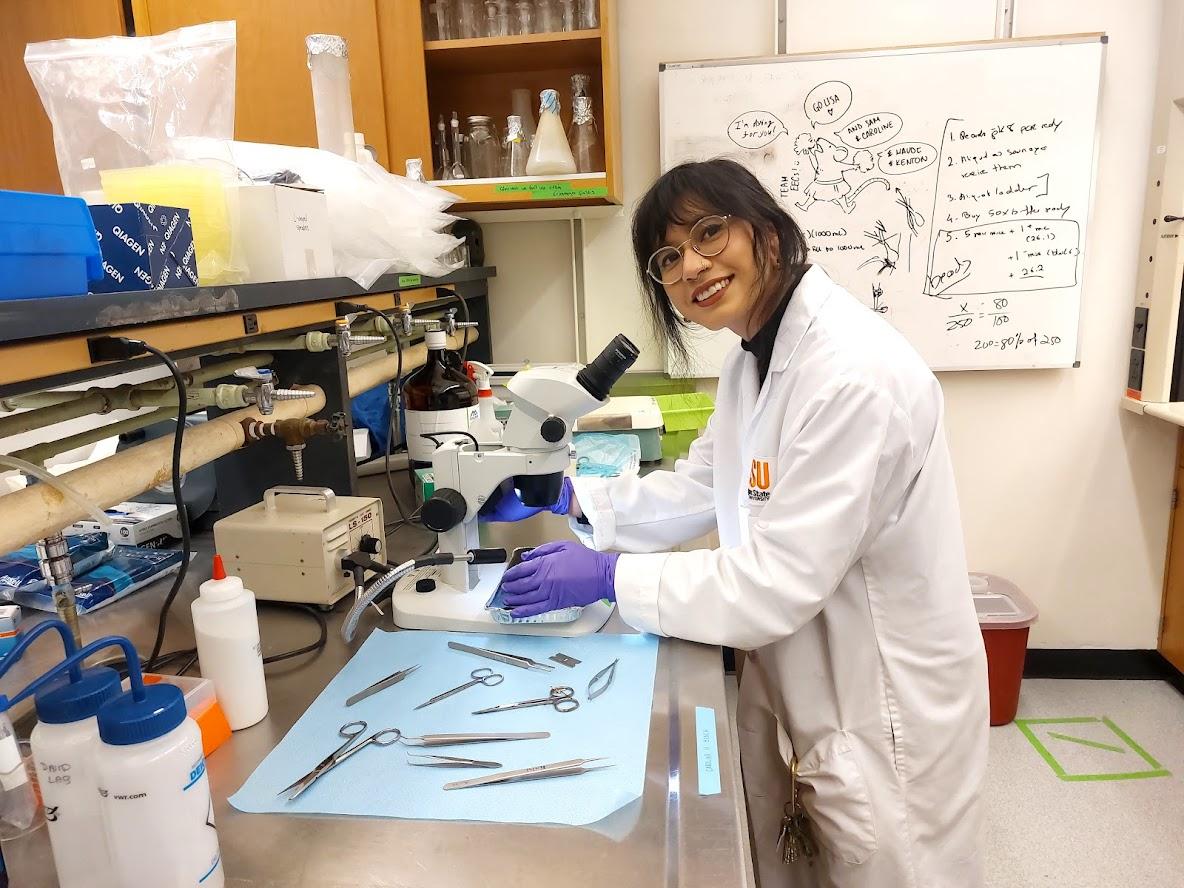Sunni Patton and Caroline Hernández entered the OSU Microbiology program as PhD students and recipients of notable awards from Achievement Rewards for College Scientists (ARCS) Foundation. Now, they have both recently received prestigious Graduate Research Fellowships from the National Science Foundation.
The NSF selects approximately 2,000 awardees from over 13,000 applicants for this highly competitive three-year fellowship for outstanding students in STEM. With their funds, Caroline and Sunni can continue their research for their respective laboratories and explore questions that have the potential to change our world as we know it.

Sunni Patton in the Vega Thurber Lab.
Sunni Patton is focused on the microbiome of coral reefs and works in Dr. Rebecca Vega Thurber’s lab to investigate the relationship between parasitic bacteria and coral.
The bacterial communities housed in coral are important to their health but can also have negative effects if the coral bacterial diversity is low or if parasitic bacteria begin to colonize it.
Patton primarily studies Caribbean coral, which is a preferred species for habitat restoration because of the rate at which it can grow. This coral can be affected by parasitic bacteria that makes it more susceptible to disease even though it appears healthy and unaffected.
So far, researchers have determined that this bacteria spreads from the environment to the coral. In the lab, Patton works to understand where this bacterium is coming from and why it is proliferating so well in certain coral species.
Her work takes her from Oregon all the way to the Florida Keys where she does field research for three to six weeks twice a year.
In her research, she uses a system called the Climate and Acidification Ocean Simulator (CAOS) to manipulate the temperature and acidification levels in controlled coral environments.
From this, she can observe how these coral environments are reacting to different stressors.
This isn’t the first time she’s worked with coral.
During her time as an undergraduate, she traveled to the St. John U.S. Virgin Islands to observe the coral reefs there and how they had been affected by Hurricane Irma. She cites this trip as one of the reasons she began to study coral and the microbiology of their reefs.
Because of this grant, Patton said she’ll be able to solely focus her time uncovering where this parasitic bacterium is coming from. She's excited for the community and professional development that comes with this grant, and is looking forward to being able to directly apply her research to coral restoration initiatives.
Because of the public interest in protecting coral reefs, Patton is optimistic about the implications of her research. "Everyone these days knows about corals and the threats they’re facing," she said. "I don’t have to work as hard to have people take action."

Caroline Hernández in the David Lab.
Caroline Hernández, a graduate student conducting research in Dr. Maude David’s lab, focuses on the human gut microbiome, specifically the connection between the gut microbiome and the brain.
She studies enteroendocrine cells, which are located in the gut and secrete hormones to communicate with the rest of the body. It was recently discovered that these enteroendocrine cells can connect with an important section of the brain, composed of vagus neurons.
This means that, in just a few milliseconds, those enteroendocrine cells can send a message from the gut all the way up to the brain. Hernández’s work takes this one step further and probes into the microbial role of this gut-brain connection.
In the lab, she studies if gut microbes can make a direct impact on these enteroendocrine cells through protein-protein interactions, which then impact nerve function.
Hernández didn’t always know that science was her calling. In fact, she started her undergraduate career as an art major, focused on creating art that looked at communication and interactions. Although she worked in mixed media, some of her art allowed observers to directly interact or touch the work she created.
She jokes that she wanted to investigate how people communicate, but decided they were too big and chose to study the communications between tiny microbes instead.
From there, she was drawn to the interactions of the gut microbiota and its host and focused on how things like diet could influence the microbiome.
Receiving the NSF grant means that Hernández can broaden her scope of research.
When she first came to OSU, she was interested in investigating the sex differences between the microbiomes. This grant will ensure that she can explore this new route alongside her pre-existing research.
With her new research, she wants to ensure that the findings are available to everyone.
"I want to make science as accessible as possible," Hernández says. "Ultimately, everyone’s got gut microbes and a brain, so understanding a bit more about that communication pathway can provide a lot of information."
By Madeleine McIntyre
BioHealth Sciences Undergraduate Student, OSU

